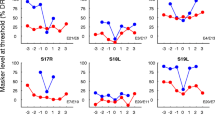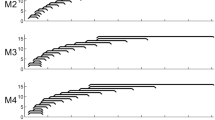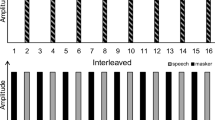Abstract
The relation between speech recognition and within-channel or across-channel (i.e., spectral tilt) intensity discrimination was measured in nine CI users (11 ears). Within-channel intensity difference limens (IDLs) were measured at four electrode locations across the electrode array. Spectral tilt difference limens were measured with (XIDL-J) and without (XIDL) level jitter. Only three subjects could perform the XIDL-J task with the amount of jitter required to limit use of within-channel cues. XIDLs (normalized to %DR) were correlated with speech recognition (r = 0.67, P = 0.019) and were highly correlated with IDLs. XIDLs were on average nearly 3 times larger than IDLs and did not vary consistently with the spatial separation of the two component electrodes. The overall pattern of results was consistent with a common underlying subject-dependent limitation in the two difference limen tasks, hypothesized to be perceptual variance (how the perception of a sound differs on different presentations), which may also underlie the correlation of XIDLs with speech recognition. Evidence that spectral tilt discrimination is more important for speech recognition than within-channel intensity discrimination was not unequivocally shown in this study. However, the results tended to support this proposition, with XIDLs more correlated with speech performance than IDLs, and the ratio XIDL/IDL also being correlated with speech recognition. If supported by further research, the importance of perceptual variance as a limiting factor in speech understanding for CI users has important implications for efforts to improve outcomes for those with poor speech recognition.





Similar content being viewed by others
Notes
4IFC DLs would be approximately 1.2 times 2IFC DLs if the same stimuli and discrimination were tested in both cases. This ratio was estimated by fitting Weibull functions to two alternative psychometric functions.
References
Alexander JM, Kluender KR (2008) Spectral tilt change in stop consonant perception. J Acoust Soc Am 123:386–396
Alexander JM, Kluender KR (2009) Spectral tilt change in stop consonant perception by listeners with hearing impairment. J Speech, Language, Hearing Res: JSLHR 52:653–670
Anderson ES, Nelson DA, Kreft H, Nelson PB, Oxenham AJ (2011) Comparing spatial tuning curves, spectral ripple resolution, and speech perception in cochlear implant users. J Acoust Soc Am 130:364–375
Anderson ES, Oxenham AJ, Nelson PB, Nelson DA (2012) Assessing the role of spectral and intensity cues in spectral ripple detection and discrimination in cochlear-implant users. J Acoust Soc Am 132:3925–3934
Azadpour M, McKay CM (2012) A psychophysical method for measuring spatial resolution in cochlear implants. J Assoc Res Otolaryngol 13:145–157
Blamey P, Artieres F, Baskent D, Bergeron F, Beynon A, Burke E, Dillier N, Dowell R, Fraysse B, Gallego S, Govaerts PJ, Green K, Huber AM, Kleine-Punte A, Maat B, Marx M, Mawman D, Mosnier I, O’Connor AF, O’Leary S, Rousset A, Schauwers K, Skarzynski H, Skarzynski PH, Sterkers O, Terranti A, Truy E, Van de Heyning P, Venail F, Vincent C, Lazard DS (2013) Factors affecting auditory performance of postlinguistically deaf adults using cochlear implants: an update with 2251 patients. Audiol Neuro-otol 18:36–47
Brochier T, McDermott HJ, McKay CM (2017) The effect of presentation level and stimulation rate on speech perception and modulation detection for cochlear implant users. J Acoust Soc Am 141:4097–4105
Dai H, Micheyl C (2010) On the choice of adequate randomization ranges for limiting the use of unwanted cues in same-different, dual-pair, and oddity tasks. Atten Percept Psychophys 72:538–547
Drennan WR, Won JH, Timme AO, Rubinstein JT (2016) Nonlinguistic outcome measures in adult cochlear implant users over the first year of implantation. Ear Hear 37:354–364
Fraser M, McKay CM (2012) Temporal modulation transfer functions in cochlear implantees using a method that limits overall loudness cues. Hear Res 283:59–69
Galvin JJ 3rd, Fu QJ (2009) Influence of stimulation rate and loudness growth on modulation detection and intensity discrimination in cochlear implant users. Hear Res 250:46–54
Henry BA, Turner CW (2003) The resolution of complex spectral patterns by cochlear implant and normal-hearing listeners. J Acoust Soc Am 113:2861–2873
Lawler M, Yu J, Aronoff JM (2017) Comparison of the spectral-temporally modulated ripple test with the Arizona Biomedical Institute sentence test in cochlear implant users. Ear Hear 38:760–766
Lazard DS, Vincent C, Venail F, Van de Heyning P, Truy E, Sterkers O, Skarzynski PH, Skarzynski H, Schauwers K, O’Leary S, Mawman D, Maat B, Kleine-Punte A, Huber AM, Green K, Govaerts PJ, Fraysse B, Dowell R, Dillier N, Burke E, Beynon A, Bergeron F, Baskent D, Artieres F, Blamey PJ (2012) Pre-, per- and postoperative factors affecting performance of postlinguistically deaf adults using cochlear implants: a new conceptual model over time. PLoS One 7:e48739
Lazard DS, Innes-Brown H, Barone P (2014) Adaptation of the communicative brain to post-lingual deafness. Evidence from functional imaging. Hear Res 307:136–143
Litvak LM, Spahr AJ, Saoji AA, Fridman GY (2007) Relationship between perception of spectral ripple and speech recognition in cochlear implant and vocoder listeners. J Acoust Soc Am 122:982–991
Lu YY, Cooke M (2009) The contribution of changes in F0 and spectral tilt to increased intelligibility of speech produced in noise. Speech Commun 51:1253–1262
Luo X, Fu QJ, Wei CG, Cao KL (2008) Speech recognition and temporal amplitude modulation processing by Mandarin-speaking cochlear implant users. Ear Hear 29:957–970
McKay CM, Henshall KR, Farrell RJ, McDermott HJ (2003) A practical method of predicting the loudness of complex electrical stimuli. J Acoust Soc Am 113:2054–2063
McKay CM, Lim HH, Lenarz T (2013) Temporal processing in the auditory system: insights from cochlear and auditory midbrain implantees. J Assoc Res Otolaryngol 14:103–124
Nelson DA, Schmitz JL, Donaldson GS, Viemeister NF, Javel E (1996) Intensity discrimination as a function of stimulus level with electric stimulation. J Acoust Soc Am 100:2393–2414
Saoji AA, Litvak L, Spahr AJ, Eddins DA (2009) Spectral modulation detection and vowel and consonant identifications in cochlear implant listeners. J Acoust Soc Am 126:955–958
Shannon RV, Zeng FG, Kamath V, Wygonski J, Ekelid M (1995) Speech recognition with primarily temporal cues. Science 270:303–304
Shepherd R, Hardie N (2001) Deafness-induced changes in the auditory pathway: implications for cochlear implants. Audiol Neuro-Otol 6:305–318
Winn MB, Litovsky RY (2015) Using speech sounds to test functional spectral resolution in listeners with cochlear implants. J Acoust Soc Am 137:1430–1442
Winn MB, Won JH, Moon IJ (2016) Assessment of spectral and temporal resolution in cochlear implant users using psychoacoustic discrimination and speech cue categorization. Ear Hear 37:e377–e390
Won JH, Drennan WR, Nie K, Jameyson EM, Rubinstein JT (2011a) Acoustic temporal modulation detection and speech perception in cochlear implant listeners. J Acoust Soc Am 130:376–388
Won JH, Jones GL, Drennan WR, Jameyson EM, Rubinstein JT (2011b) Evidence of across-channel processing for spectral-ripple discrimination in cochlear implant listeners. J Acoust Soc Am 130:2088–2097
Won JH, Humphrey EL, Yeager KR, Martinez AA, Robinson CH, Mills KE, Johnstone PM, Moon IJ, Woo J (2014) Relationship among the physiologic channel interactions, spectral-ripple discrimination, and vowel identification in cochlear implant users. J Acoust Soc Am 136:2714–2725
Zakis J A, McDermott H J. (1999) A new digital sound processor for hearing research IEEE Engineering in Medicine and Biology Society Conference; Biomedical Research in the Third Millennium. Melbourne, Australia
Acknowledgements
The ImpResS software was jointly developed by the University of Melbourne and Medical Research Council (UK), and the SPEAR research processor was developed by the Hearing Cooperative Research Centre in Melbourne.
Funding
The research was supported by Veski and Lions fellowships to the first author. The Bionics Institute acknowledges the support of the Victorian Government through its Operational Infrastructure Support program.
Author information
Authors and Affiliations
Corresponding author
Ethics declarations
Conflict of Interest
The authors declare that they have no conflict of interest.
Rights and permissions
About this article
Cite this article
McKay, C.M., Rickard, N. & Henshall, K. Intensity Discrimination and Speech Recognition of Cochlear Implant Users. JARO 19, 589–600 (2018). https://doi.org/10.1007/s10162-018-0675-7
Received:
Accepted:
Published:
Issue Date:
DOI: https://doi.org/10.1007/s10162-018-0675-7




